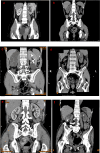Effect of retention time on renal function and kidney size in patients with indwelling DJ tubes
- PMID: 40374676
- PMCID: PMC12081938
- DOI: 10.1038/s41598-025-01191-z
Effect of retention time on renal function and kidney size in patients with indwelling DJ tubes
Abstract
The impact of DJ tube retention time on renal function has received scant attention from researchers. Nevertheless, there is a plethora of clinical evidence indicating that protracted stent retention can result in renal insufficiency, or even renal atrophy, which can consequently lead to loss of renal function or nephrectomy.A comprehensive review of the medical records of all patients who underwent DJ tube placement between 1 January 2010 and 1 September 2024 in our hospital was performed. Cases with a duration of DJ tube placement exceeding two years were selected for further analysis, as supported by previous studies. The final study population comprised 74 cases with indwelling DJ tubes for a minimum of two years. Renal size/glomerular width (PW) was measured on the basis of CT coronal scanning, and the mean value of PW and the rate of change of PW were calculated before the first placement of the DJ tube and at the last follow-up, respectively. Furthermore, the study recorded eGFR, serum creatinine (Scr), blood urea nitrogen (BUN), and blood uric acid (UA) at two time points: before and after DJ tube placement. The mean duration of indwelling DJ tubes was 67.94 ± 48.26 months in the unilateral DJ tube indwelling group (including isolated kidney cases) and 50.22 ± 29.65 months in the bilateral group. During the mean retention time of 67.94 ± 48.26 months, the mean PW change rates of unilateral DJ tube stented kidneys and healthy kidneys/unilateral kidneys were - 39.01 ± 26.1% and 16.52 ± 25.4%, respectively, which were statistically significant (P < 0.01). The mean rate of change in PW in the left and right sides of the bilateral DJ tube retention group was - 18.31 ± 36.3% over a mean retention time of 50.22 ± 29.65 months, which was statistically significant (P < 0.01). Furthermore, a statistically significant decrease of -37.81 ± 51.2% in eGFR was observed before and after bilateral DJ tube placement (P < 0.01). No statistically significant difference (P > 0.05) was observed in eGFR in the unilateral DJ tube placement group (including isolated kidney cases) and in Scr, BUN, and UA values in the unilateral and bilateral DJ tube placement groups before and after DJ tube placement. In the unilateral DJ tube-placement group, the duration of DJ tube placement exhibited a negative correlation with the rate of change in mean PW percentage (Pearson correlation coefficient r = -0.470, P = 0.002) and a positive correlation with the rate of change in eGFR (Pearson correlation coefficient r = 0.653, P < 0.01). Conversely, in the bilateral DJ tube retention group, DJ tube retention duration exhibited no significant correlation with the change in mean percentage of PW.However, it demonstrated a negative correlation with the rate of change in eGFR (Pearson correlation coefficient r = -0.443, P = 0.03). In patients with unilateral or bilateral indwelling DJ tubes, renal size may decrease over time despite the presence of an indwelling DJ tube, especially in patients with bilateral indwelling DJ tubes.
Keywords: DJ tube; Renal function; Renal parenchymal; Ureteral stents.
© 2025. The Author(s).
Conflict of interest statement
Declarations. Competing interests: The authors declare no competing interests. Ethical statement: The protocol of this study was approved by the Institutional Review Board of the First Hospital of Xiamen University.Informed consent was obtained from the patients for the case data and information used in this manuscript.
Figures



Similar articles
-
Change of Renal Parenchymal Width in Patients with Unilateral Ureteral Stent: A Bicenter Retrospective Study.Biomed Res Int. 2017;2017:1653184. doi: 10.1155/2017/1653184. Epub 2017 Jun 1. Biomed Res Int. 2017. PMID: 28656136 Free PMC article.
-
Vesicoureteral Reflux.2024 Apr 30. In: StatPearls [Internet]. Treasure Island (FL): StatPearls Publishing; 2025 Jan–. 2024 Apr 30. In: StatPearls [Internet]. Treasure Island (FL): StatPearls Publishing; 2025 Jan–. PMID: 33085409 Free Books & Documents.
-
An arterial spin labeling-based radiomics signature and machine learning for the prediction and detection of various stages of kidney damage due to diabetes.Front Endocrinol (Lausanne). 2024 Nov 18;15:1333881. doi: 10.3389/fendo.2024.1333881. eCollection 2024. Front Endocrinol (Lausanne). 2024. PMID: 39624821 Free PMC article.
-
[Evaluation of the Effects of Long-Term Indwelling Ureteral Stents on Preserving Renal Parenchyma and Function in Patients with Ureteral Stenosis].Hinyokika Kiyo. 2023 Oct;69(10):279-287. doi: 10.14989/ActaUrolJap_69_10_279. Hinyokika Kiyo. 2023. PMID: 37914373 Japanese.
-
Would the indwelling internal ureteral stent influence renal function despite relief of benign ureteral obstruction?J Endourol. 2014 Feb;28(2):243-7. doi: 10.1089/end.2013.0521. Epub 2013 Oct 23. J Endourol. 2014. PMID: 24032464
References
-
- Tomer, N., Garden, E., Small, A. & Palese, M. Ureteral stent encrustation: epidemiology, pathophysiology, management and current technology. J. Urol.205 (1), 68–77 (2021). - PubMed
-
- Liatsikos, E. N. et al. Ureteral metal stents: 10-year experience with malignant ureteral obstruction treatment. J. Urol.182 (6), 2613–2617 (2009). - PubMed
-
- Haifler, M. et al. Tandem ureteral stents for malignant ureteral obstruction. J. Endourol. 34 (2), 222–226 (2020). - PubMed
-
- Kang, Q., Jiang, F., Yu, Y. & Yang, B. Application of metallic ureteral stents in gynecological malignancies: a literature review. Minim. Invasive Ther. Allied Technol.29 (1), 1–9 (2020). - PubMed
MeSH terms
Substances
Grants and funding
LinkOut - more resources
Full Text Sources
Research Materials
Miscellaneous

